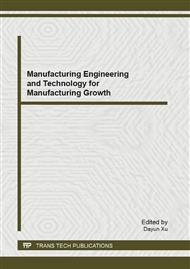[1]
Ai H.X., D.H. Wang, W.H. Liao: Design and Modelling of a Magnetorheological Valve with Both Annular and Radial Flow Paths. J. Int. Mat. Syst. Struct., vol. 17 (2006).
Google Scholar
[2]
F. Akgun, R.H. Jawad: Determination of Friction Factor of Fluids Flowing Turbulently Through an Eccentric Annulus. Int. J. Petr. Sc. and Tech., vol. 1, no. 1, 2007, p.37–49.
Google Scholar
[3]
A.L. Browne at al.: Bi-fold valve-type magnetorheological fluid energy absorbing device, US 7900755 B2 (2011).
Google Scholar
[4]
A.T. Bourgoyne Jr. et al.: Applied Drilling Engineering. Society of Petroleum Engineers, Richardson, TX, (1991).
Google Scholar
[5]
A. Grunwald, A. G. Olabi: Design of magneto-rheological (MR) valve. Sensors and Actuators. no. A 148, pp.211-223 (2008).
DOI: 10.1016/j.sna.2008.07.028
Google Scholar
[6]
J. Kowal, P. Martynowicz, B. Sapiński, Z. Szydło: Sterowany zawór dławiący przepływ cieczy magnetoreologicznej, dwustronnego działania. Patent application no. P-391189 (2010).
Google Scholar
[7]
Z. Matras: Transport hydrauliczny reologicznie złożonych cieczy nienewtonowskich w przewodach. Wydawnictwo PANDIT, Kraków (2001).
Google Scholar
[8]
P. Martynowicz, Z. Szydło: Special Application Magnetorheological Valve Design Study. Scientific Aspects of Unmanned Mobile Vehicle, PTMTS, Kielce (2010).
Google Scholar
[9]
Q. H. Nguyen, Y. M. Han, S. B. Choi, N. M. Wereley: Geometry optimization of MR valves constrained in a specific volume using the finite element method. Smart Materials and Structures. no. 16, pp.2242-2252, (2007).
DOI: 10.1088/0964-1726/16/6/027
Google Scholar
[10]
S. Kciuk, P. Martynowicz: Special application magnetorheological valve numerical and experimental analysis, Diffusion and Defect Data – Solid State Data. Pt. B, Solid State Phenomena ; ISSN 1012-0394. — 2011 vol. 177: Control engineering in materials processing s. 102–115. — Bibliogr. s. 115, Abstr.
DOI: 10.4028/www.scientific.net/ssp.177.102
Google Scholar


